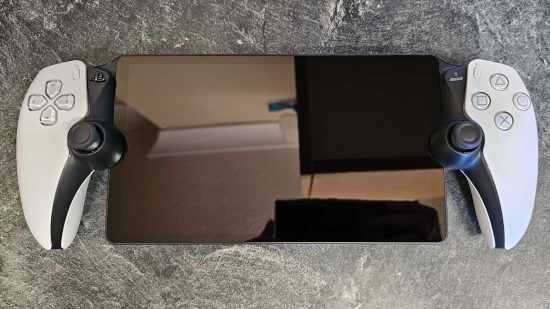Our Verdict
The PlayStation Portal offers an equal amount of great and disappointing features. Its decent performance and premium feel are let down by weak battery life and a screen that doesn’t make up for the high asking price.
It’s been over ten years since the release of the PlayStation Vita, Sony’s last handheld gaming console. With the Nintendo Switch and Steam Deck proving that there’s still a market for portable consoles, it was no surprise that Sony would get back into the race. What was a surprise, however, was the fact that the PlayStation Portal was announced as a Remote Play device solely for the PS5.
Is it one of the best PS5 accessories or, technically, one of the best PS5 controllers? It depends on if you fit an admittedly very niche market for this piece of gaming gear. Despite Remote Play being readily available on a device you’re likely reading this review on, PlayStation clearly believes there’s an audience that will pay a premium for a dedicated device to remotely play the best PS5 games, and honestly, I think that’s true. At least, for some.
Pros
- Feels premium with a reliable and sturdy design
- PS5 games work extremely well remotely
- Easy to use and perfect for playing when there’s an occupied TV
Cons
- Niche use case
- Doesn’t come with a carrying or protective case
- The charge rate and battery life are disappointing
Specs
PlayStation Portal specs:
| Screen size/resolution | 8 inches / 1080p60 |
| Screen type | LCD |
| Battery life | 6-8 hours |
| Charge rate | Around 2 hours |
| Bluetooth connectivity | N/A |
| Features | Remote Play-only, PlayStation Link, Haptic Feedback, Adaptive Triggers |
PlayStation Portal’s rather large screen is extremely bright, offering beautiful visuals despite the fact it is an LCD screen as opposed to an OLED. A lack of Bluetooth connectivity is fairly disappointing, meaning you’ll have to open your wallets and buy some PlayStation Link-enabled headphones or earbuds (which are coming soon) to listen to your game wirelessly. Or you can find one of the best wired headsets, thanks to the 3.5mm headphone jack.
Features
Unlike most portable devices that are taking the market by storm right now, the PlayStation Portal is not capable of playing games on dedicated hardware. Instead, Sony has opted to make the Portal a solely Remote Play device. Unlike the Remote Play app on PC or Android and iOS, it’s a lot less finicky but offers less customization such as changing the resolution or connecting to a PS4.
Unfortunately, less customization can be a bad thing for such a niche device. Portable consoles (or PCs) like the Steam Deck can do everything that the PlayStation Portal can do (which is only Remote Play), as well as play PC games, use Xbox Cloud Gaming, and a whole lot more. Or in the case of the Switch, you have many, many games that don’t require being tethered to the internet.
Design
Straight out of the box, the PlayStation Portal makes a good first impression. On either side of the huge 8-inch screen are halves of a DualSense controller. Obviously, the screen itself is the touchpad, while the PS button has moved to the left side and the microphone button lives on the right.
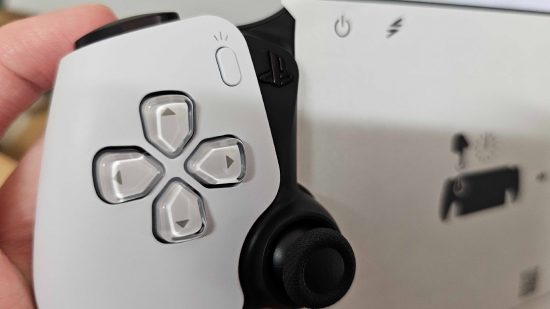
Picking up the PlayStation Portal, my first thought was how it had more weight to it than I expected. It’s not as heavy as the chunk of a computer that is the Steam Deck, but it certainly feels heavier than the standard Nintendo Switch and its Lite-r brother. However, the premium feel of the DualSense and the ease of gripping it feels much better than both, with the Switch’s small design feeling difficult to hold most of the time in my moderately-sized hands, while Steam Deck’s weight can make it hard for long play sessions.
The controller itself feels just as you’d expect when playing with a DualSense. The buttons have firm feedback upon pressing them, the triggers all have a great response, and the thumb sticks have enough tension when moving them that you won’t be worried about accidentally causing your character to do a 180-turn in the middle of combat.
Considering how many devices recently offer extremely small bezels on screens, it’s surprising that the PlayStation Portal has a fairly large one. During play sessions, it doesn’t matter too much, but it’s something to note. We’ll go more into the screen in the performance section, but overall, the design of the PlayStation Portal is fairly impressive, yet simple.
Performance
The biggest concern with the PlayStation Portal for most players will undoubtedly be the lag. Unlike cloud gaming, where your device will simply connect to some servers, your PS5 has to connect to your router, pass that information to your router or other device, and then transfer it to your PlayStation Portal and vice versa. While I had no issues with lag during my time with the PlayStation Portal, I understand I’m in a place of luck, with a great router capable of 5GHz WiFi and extremely fast speeds.
It’s worth mentioning that, in my years of using Remote Play, I’ve had no end of issues. It seems like Remote Play can be fairly volatile, with the same setup sometimes producing perfect results, while other times delivering potato-like visuals and laggy response times. I didn’t experience this with the PlayStation Portal, aside from one hiccup upon launching it for the first time where the home screen looked muddy. After launching a game, it looked crystal clear.
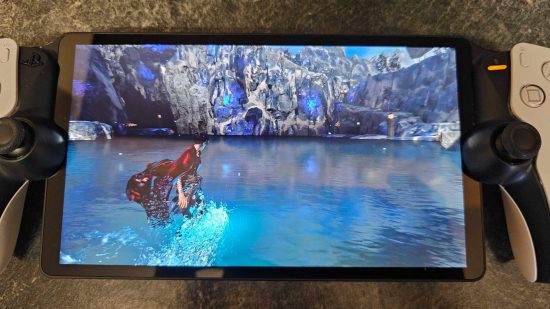
The PlayStation Portal’s screen is barely fine. While it does look bright and works well outdoors, the colors are washed out – as you’d expect with an LCD screen. An LED or OLED screen would’ve been able to help the blacks and colors pop, but as it stands, shadowy areas have a hint of gray to them. There’s a good reason many mobile phones and handheld consoles are moving to OLED screens, but it seems PlayStation may have missed that memo.
The majority of my time was spent rushing objectives in Call of Duty MW3 or swinging across New York City in Marvel’s Spider-Man 2. I wouldn’t recommend playing competitive games on the Portal, as it can be quite difficult using the best MW3 guns on such a small screen. However, single-player games felt equal to playing on the PS5 itself, which is much better than my previous sessions with Remote Play.
All of the bells and whistles of the DualSense are within the PlayStation Portal, like the adaptive triggers adding to the immersion of many titles. The haptic feedback is also present here, but it’s a bit over the top for my liking, as with the volume turned mostly down on the Portal, the overpowering noise of the haptic feedback is very loud. But it’s nice to have these great features on a portable device.
Speaking of the speakers (excuse the pun), the PlayStation Portal certainly is loud. Even at just one notch up from mute the Portal offers a fair amount of volume, so much, in fact, that it feels like it’s close to half of the volume of my iPhone 14 at just one bar. As you can imagine, at full volume, it can be fairly loud, so we’d recommend not playing this without some headphones or earbuds when in public, or if someone is watching TV right next to you. Admittedly, the sound quality is very good, and from such a small device, it’s certainly enough for play sessions. It sounds just as great as an iPhone, although I imagine the experience is much more immersive with a pair of PlayStation Link headphones.
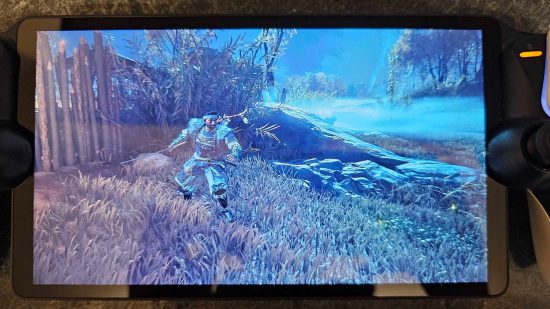
PlayStation Portal’s battery life is also nothing to write home about. It drops about 30% in around 2 hours, depending on what game you’re playing. Games with lots of immersive features like Call of Duty will no doubt drain the battery faster, and despite using USB-C cables for charging, it can take a while to charge from dead to full, taking a couple of hours to get back to 100%.
Just like the DualSense controllers on the PS5, I found that turning down the haptic feedback on the Portal increased its battery life, but not by much. I found that turning them off gave me about an extra hour of battery life, but that’s a pretty big price to pay for losing the immersive experience of haptics – something that sets the Portal apart from its main competitor, the Backbone One.
While the Backbone is certainly the cheaper option for playing games on the go, it’s not the definitive way to play. I’ve had a lot of experience with the Backbone since launch to play the best mobile games, and as a cheaper option, it does a great job at being an all-around solution for playing games via the cloud and remotely. But for all of the Portal’s flaws, Sony’s device is a much better option for playing games via Remote Play – especially if that’s your sole reason for purchasing. That being said, considering how poorly the device works on mobile hotspot, if at all, I imagine it would’ve been a lackluster experience.
Speaking of cloud gaming, annoyingly, the PlayStation Portal doesn’t offer Cloud Streaming for PS Plus Premium subscribers, a sorely missed opportunity if I’ve ever seen one. Having hundreds of titles in the near future available on the PlayStation Portal, and playing them by simply connecting to the servers would make this device worth the high price. As it stands, unless PlayStation can add it as a future firmware update, it’s something that should’ve really been considered.
I was excited to experience the PlayStation Portal, but, unfortunately, it left me with a sour taste in my mouth. While it’s certainly the best way to use Remote Play currently, the washed-out screen, lack of cloud gaming support, and so-so battery life make me wish for a better, but unlikely, PlayStation Portal 2.
Where to buy the PlayStation Portal
You can purchase the PlayStation Portal from Amazon, Best Buy, GameStop, GAME UK, or PlayStation Direct. Stocks are running low though, so you might have to check eBay.
Should you buy the PlayStation Portal?
- Yes: if you want a premium Remote Play device
- Yes: if you find your TV time limited
- Yes: if you want something for quick gaming sessions
- No: if you want an all-round gaming experience
- No: if you’re looking to play cloud gaming
- No: if you own a Steam Deck or a decent mobile device
The PlayStation Portal is a great device for those with a very specific need for it. If you’re solely a PS5 player and find your partner, your kids, or other relatives are hogging the TV, and you simply want to enjoy some PS5 exclusives, then the PlayStation Portal might be a great option for you.
For everyone else, the PlayStation Portal isn’t worth picking up right now at full price. A shallow battery life for a WiFi-connected device that requires an expensive console on its own, while also offering less compatibility and features than something like the Backbone One makes it a tough sell for the major audience.
If the PlayStation Portal isn’t for you
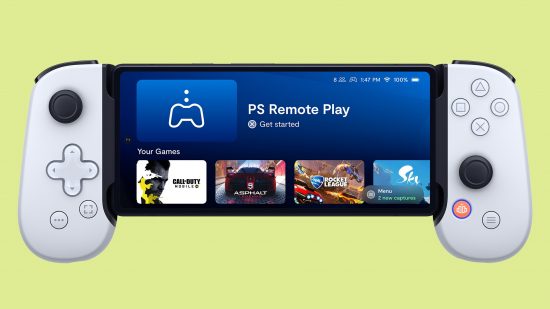
Backbone One: a mobile gaming controller that offers a similar experience to the Portal while allowing for mobile games, cloud gaming, and more.
The Backbone One is the biggest competitor for the PlayStation Portal, if you have one of the best gaming phones that is. Not only can you play Remote Play via your phone using the Backbone, but you can also use it for Xbox Cloud Streaming, and other mobile games. While it doesn’t feel as premium as the PlayStation Portal, it does offer more compatibility for half the price.
Verdict
The PlayStation Portal is a great option… for a small subset of users. It delivers the best Remote Play experience compared to the app or PC versions, with a premium feel. That being said, its limited battery life, washed-out colors, and expensive price make it a difficult choice compared to other handheld consoles.
